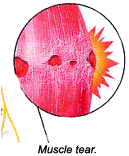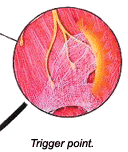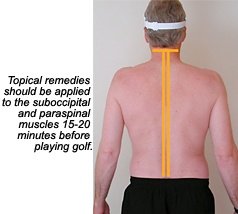We call tissue tears "strains" or "sprains," depending on their severity. Soft-tissue injuries can heal in six to eight weeks, depending on the severity of the injury and the age of the patient. However, when soft tissue heals, it becomes weaker than before the injury occurred. The injury site will mend with scars you cannot see. Scar tissue (fibrocytes) will infiltrate and replace the original tissue in and around the injury site. Fibrocytes are weaker, less elastic and more pain-sensitive than original soft tissue. When challenged by the movement of the body, fibrocytes will not lengthen and give way; instead, they get angry; become irritated and inflamed; and restrict normal joint motion.
Clinical Management: Acute Versus Chronic Injury
Golf injuries fall under two general categories: acute and chronic. Acute injuries are new injuries, and are usually associated with painful swelling. An acute injury prevents you from playing golf altogether. The first four to six weeks are crucial in the management/treatment of a new injury. In addition to pain relief, the goal of treatment is to reorganize the developing fibrocytes so they are more compatible with the surrounding tissue.
No treatment can prevent the formation of fibrocytes; however, left unattended, they will form into an ugly tangled mess that is considered a nonfunctional scar. To a patient, this means increased sensitivity to pain and greater loss of normal joint motion.
Golfers with acute injuries should get complete rest. Ice packs are recommended to reduce painful swelling. The ice can be applied for as long as 20 minutes per hour - in other words - 20 minutes "on," then 40 minutes "off." Repeat as often as necessary during the first 24-48 hours of an acute injury; follow-up with a treatment program specifically designed to reorganize the fibrocytes into a "functional" scar. As the treating physician, you have several excellent soft-tissue therapy techniques to choose from, including neuromuscular re-education and active release techniques). The long-term benefit will be less pain and greater range of joint motion.
Golfers with chronic injuries have a unique problem to overcome. Old injuries are often infiltrated with dense clusters of nonfunctional fibrocytes: trigger points. With overuse, trigger points will inflame and feel like a new injury again.
Usually, chronic injuries are associated with stiffness. A golfer with chronic injuries changes his or her swing to avoid pain. It's hard to play consistent, powerful golf with chronic injuries.
Treatment ProtocolThe truth is, many of your patients who play golf are borderline obsessive about playing golf - injured or not. Therefore, effective patient management requires professional in-office adjustments, physical therapy, and a specific home-care treatment protocol.
I have discovered an effective remedy for golfers with chronic stiffness1 that includes four key ingredients:
- capsaicin: synthesized from hot peppers; an FDA-approved over-the-counter agent for pain relief; known to deplete the level of substance (SP), a neurotransmitter to the brain. By depleting SP, the pain signal is diminished.
- turmeric: more commonly known as a spice in Indian food; known to reduce inflammation and inhibit the production of inflammatory enzymes.
- glucosamine: a well-known, potent anti-inflammatory.
- methylsulfonlmethane (MSM): a natural form of bio-available sulfur that acts as a cellular transporter to carry the ingredients efficiently through the dermal layer.
For home use, the remedy is available in a roll-on that can be carried in the golf bag. For office treatment, I recommend supplementing with ultrasound to drive the solution deep into the connective tissues.
Source
- www.playonproducts.com
Jeffry Blanchard, DC
Encinitas, California
DoctorForGolf.com
Dr. Jeff Blanchard is a practicing chiropractor who competes as a golf professional. He is the author of The PGA Professionals' Golf Injury Desk Reference (2007). For questions or comments regarding this article, contact Dr. Blanchard at 805-772-8298 or .







